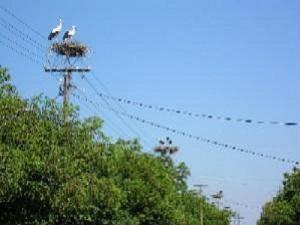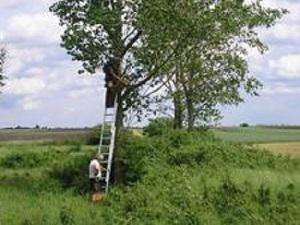Marko Tucakov
Other projects
The White Stork – a flagship species for the lower Tamis river protection in Serbia

In Serbia, a quarter of all White Stork (Ciconia ciconia) pairs breed in the villages along the lower Tamis river (in Vojvodina, the Pannonian province of Serbia), where excellent feeding grounds are still preserved. However, out of 273 local nests, 94 are placed on electrical transmission pylons. The threat that nesting on overhead wires poses to breeding has, together with the loss of traditional feeding areas, resulted in a clear reduction in the White Stork population in Serbia.

Land run through by the Tamis is rich in its variety of endangered habitats: 11,000 ha of ancient riverine forests still exist in the floodplain. Traditional villages, with their old rural architecture, are situated on the forest edges. The whole mosaic of habitats is of crucial importance for wildlife, particularly for birds. The Eurasian Spoonbill, Pigmy Cormorant, Ferruginous Duck, White-tailed Eagle, Whiskered Tern and even the Glossy Ibis are just some of the regular and potential breeding birds in the area.
Preliminary data, as yet incomplete, indicates a rich biodiversity in the habitats along the lower Tamis; the White Stork, as a characteristic and charismatic species, will be used as a tool to preserve and promote the local natural heritage. This action is particularly important in the 23 local villages, and we will use direct contact, distributed information material and the media. At the same time we will carry out detailed habitat and species mapping – with emphasis on the avifauna. The main philosophy of the project is based around physical protection of the local White Stork population by erecting artificial nesting platforms on the pylons, outside the breeding season. This very visible action will address the conservation needs of the whole area as well as sending a message to the local community that they have something worth protecting, and the power to do something about this lies in their hands.
Three levels of activities will be performed:
The local community: local wardens will be identified and trained for the protection of White Stork nests (i.e. local people who might have a nest on their house). Working meetings will be held, to promote local natural values and the need for their protection.
The municipality: the future of White Storks and their habitat locally is very dependent on the local authorities: thus a local White Stork Protection Plan (WSPP) will be prepared and presented to the Councils of five local municipalities.
Other stakeholders: meetings will be held with heads of the large state-owned utilities, in order to work towards sustainable solutions for future use of local resources: these should harmonize their interests with conservation needs. There are two major companies in the target group: the provincial water management, and the provincial forest company.